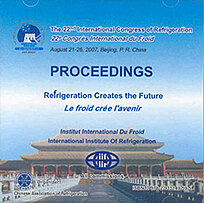
IIR document
Energy analysis of the ice-making process for a liquid-liquid circulating fluidized bed.
Author(s) : LIANG K. F., WEI Y., WANG Z. Y., et al.
Summary
A novel method of dynamic ice forming, liquid-liquid circulating fluidized bed, was studied by using direct contact heat transfer between drops and the coolant for ice storage system. In order to simulate the multiphase flows and heat transfer in circulating fluidized bed, a numerical model was developed. Energy discharge was discussed for liquid-liquid circulating fluidized bed based on the second law of thermodynamics. Numerical method was used to study the influence of operating parameters, such as the droplet diameter and the inlet temperature or velocity average of liquid phase, on the ice-making performance and total energy discharge in the dynamic ice-making process. The research results indicate that ice-making performance always increases with decreasing droplet diameter and the inlet temperature of liquid phase and not so much with decreasing the inlet temperature of liquid phase. Moreover, decreasing the droplet diameter is considered to be the best way with consideration of the contradiction of ice-making performance and energy discharge.
Available documents
Format PDF
Pages: ICR07-E1-738
Available
Public price
20 €
Member price*
Free
* Best rate depending on membership category (see the detailed benefits of individual and corporate memberships).
Details
- Original title: Energy analysis of the ice-making process for a liquid-liquid circulating fluidized bed.
- Record ID : 2007-2670
- Languages: English
- Source: ICR 2007. Refrigeration Creates the Future. Proceedings of the 22nd IIR International Congress of Refrigeration.
- Publication date: 2007/08/21
Links
See other articles from the proceedings (839)
See the conference proceedings
Indexing
- Themes: Thermal energy storage
- Keywords: Ice bank; Ice; Manufacture; Design; Process; Modelling; Droplet; Thermal energy storage
-
Eine strukturierte Auslegungsmethodik für Eissp...
- Author(s) : BUCHNER S., HILLIGWEG A.
- Date : 2005/11/16
- Languages : German
- Source: DKV-Tagungsbericht 2005, Würzburg./ 2005 Proceedings of the DKV Conference, Würzburg.
View record
-
Experimental study on direct evaporation ice-on...
- Author(s) : LIU Y., ZHOU G., LI A.
- Date : 2007/08/21
- Languages : English
- Source: ICR 2007. Refrigeration Creates the Future. Proceedings of the 22nd IIR International Congress of Refrigeration.
- Formats : PDF
View record
-
Development and experimental study on the verti...
- Author(s) : ZHANG B. G., YOU S. J., LIU M.
- Date : 2007/08/21
- Languages : English
- Source: ICR 2007. Refrigeration Creates the Future. Proceedings of the 22nd IIR International Congress of Refrigeration.
- Formats : PDF
View record
-
Konstruktion und Betrieb eines kleinen Eisspeic...
- Author(s) : KOLLER T., ZETZSCHE M., MÜLLER-STEINHAGEN H.
- Date : 2007/11/21
- Languages : German
- Source: DKV-Tagungsbericht 2007, Hannover.
View record
-
Eiserzeugung und Eisspeicherung mit Wasser als ...
- Author(s) : ALBRING P.
- Date : 2009/11/18
- Languages : German
- Source: Deutsche Kälte-Klima-Tagung: 2009, Berlin.
View record
